Table of Contents
Looking to understand amanita muscaria benefits? You’ve come to the right place!
Amanita muscaria, commonly known as the fly agaric mushroom, has intrigued people for centuries with its distinctive appearance, hallucinogenic properties, and historical uses as a psychoactive compound among psychedelic mushrooms. Beyond its iconic red and white cap, psychedelic mushrooms offer a complex array of benefits that have been explored in various cultural, medicinal contexts, and traditional medicine, particularly for their hallucinogenic properties. This post aims to shed light on the intriguing advantages associated with Amanita muscaria, a psychedelic plant known as masha, from traditional applications in shamanic rituals to contemporary research into its potential health benefits, including medicine and microdoses. By delving into scientific studies and historical records, we uncover how this enigmatic fungus, often associated with psychedelic plants and traditional medicine, might offer more than just an interesting story about life, suggesting possibilities for wellness and therapeutic uses in microdoses that are yet to be fully understood.
Key Takeaways
- Amanita Muscaria’s Unique Chemistry: The chemical composition of Amanita Muscaria, including compounds like muscimol and ibotenic acid, sets it apart from other mushrooms, offering unique effects and potential benefits.
- Potential Medicinal Value: Research highlights Amanita Muscaria’s medicinal properties, such as anti-inflammatory and neuroprotective effects, suggesting potential therapeutic uses in managing various health conditions.
- Micro-Dosing Insights: Micro-dosing Amanita Muscaria may offer benefits like enhanced mood and creativity, but it’s crucial to approach this practice with caution due to the mushroom’s potent effects and legal considerations.
- Comparative Perspective: When comparing Amanita Muscaria with other mushrooms, its distinctive effects and potential applications become evident, emphasizing its unique place in both traditional and modern medicine.
- Legal and Safety Considerations: Understanding the legal status and regulations of Amanita Muscaria in your region is essential, as is being aware of its risks and safety profile to avoid adverse effects.
- Exploring Addiction Treatment: Emerging research into Amanita Muscaria’s use in addiction treatment shows promise, but more studies are needed to fully understand its efficacy and safety in this context.
A Quick Introduction
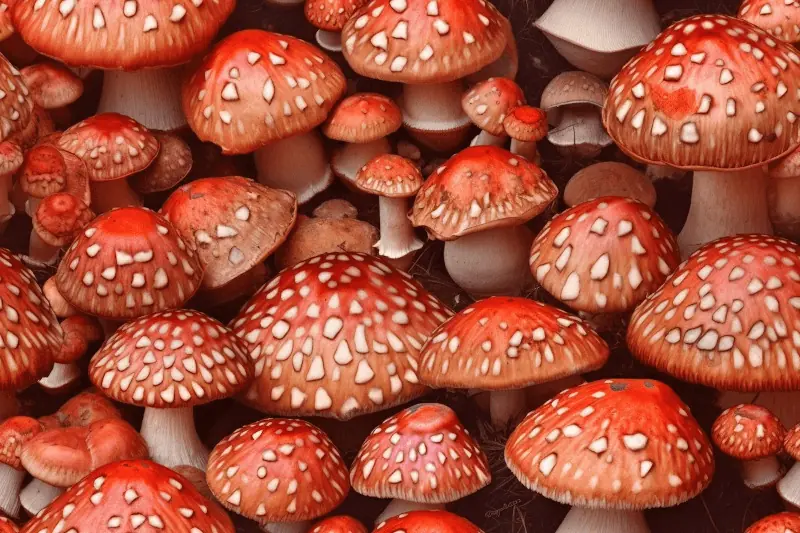
Historical Significance
Amanita muscaria mushrooms have a rich history. They were crucial in shamanic rituals for centuries. Shamans used them to enter altered states of consciousness. This practice was widespread across Siberia and Northern Europe.
The mushroom, also a psychedelic plant, has a symbolic presence in Christmas folklore, embodying life and often associated with Masha in microdoses. Some theories suggest that its red and white colors influenced modern Santa Claus attire. This connection adds a mystical layer to our holiday traditions.
Interestingly, Amanita muscaria once served as legal tender in Siberia. People traded them like currency for goods and services. This fact highlights their value beyond the spiritual realm.
Ancient religious art often features these mushrooms, indicating their sacred status. From cave paintings to manuscript illustrations, they symbolize enlightenment and rebirth.
Cultural Importance
In many cultures, Amanita muscaria represents wisdom and enlightenment. These societies view the mushroom as a key to understanding deeper truths about the universe.
It is integral to the folklore of Northern Europe where it appears in numerous myths and stories. Legends often depict it as a bridge between the earthly realm and spiritual worlds.
Traditional healing ceremonies also use this mushroom for its psychoactive properties. It plays a role in rituals aimed at physical or emotional healing.
In modern times, Amanita muscaria influences pop culture and literature significantly.
- Books like “Alice in Wonderland” hint at its mind-altering effects.
- Video games feature characters inspired by its iconic appearance. These references keep the mushroom relevant today.
Natural Habitat
Amanita muscaria thrives best in certain environments:
- Boreal forests with cold climates
- Temperate woodlands offering milder temperatures Both settings provide ideal conditions for growth.
This species commonly grows under birch trees but can also be found beneath pines, oaks, and firs. Its association with birch trees is especially notable due to mutual benefits between plant and fungus.
The distribution of Amanita muscaria spans across:
- The Northern Hemisphere
- Parts of Asia
- North America
- Europe
It prefers moist, acidic soil which helps explain its wide range yet specific locations within these regions.
By exploring both historical significance and cultural importance we gain insight into how deeply ingrained Amanita muscaria is within various societies throughout time.
Understanding its natural habitat allows us better appreciate why this fascinating species captivates so many people worldwide.
Chemical Composition
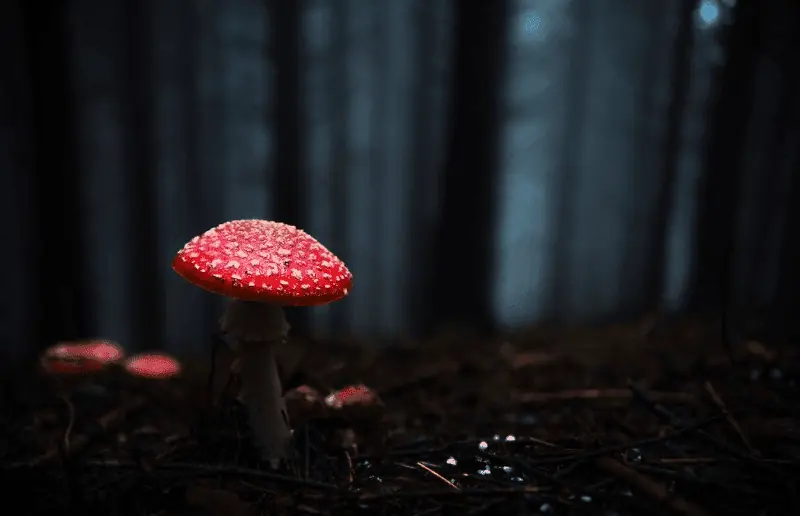
Ibotenic Acid
Ibotenic acid plays a crucial role in the psychoactive properties of Amanita muscaria. This compound is a precursor to another important compound, muscimol, through a process called decarboxylation. When ingested raw, ibotenic acid can cause effects ranging from mild to severe.
The potency of ibotenic acid decreases when the mushroom dries or cooks. This reduction in potency makes it less dangerous but still significant for those seeking its psychoactive benefits. Understanding this compound’s behavior is essential for safely utilizing Amanita muscaria.
Despite its potential hazards, the presence of ibotenic acid contributes significantly to the mushroom’s unique characteristics. It’s fascinating how such compounds interact with human biology to produce profound effects.
Muscimol
Muscimol stands as the primary psychoactive component found in Amanita muscaria mushrooms. Unlike ibotenic acid, muscimol directly acts on GABA receptors within the brain. This action induces altered states of consciousness that many users seek.
This compound is notably less toxic than ibotenic acid after conversion, making it an interesting subject for further research into therapeutic applications. The processes through which these compounds affect human cognition and perception are complex and captivating.
The transformation from ibotenic acid to muscimol not only reduces toxicity but also changes the nature of its psychoactivity. Such chemical reactions highlight nature’s intricate chemistry and its impact on humans seeking altered experiences or therapeutic benefits from natural sources like Amanita muscaria.
Medicinal Properties of Amanita Muscaria
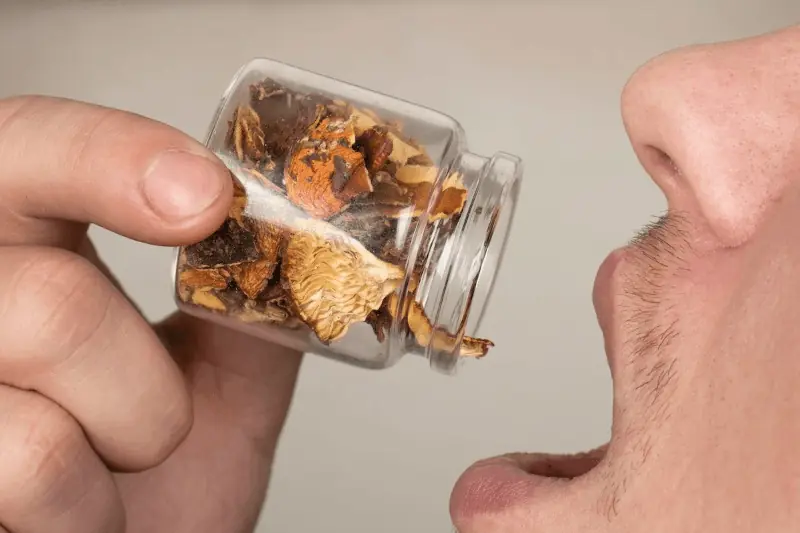
Health Promotion
Amanita muscaria, often recognized for its iconic appearance in folklore and fairy tales, holds medicinal properties that are garnering attention in scientific communities. Its potential health benefits span from antioxidant capabilities to immune system support.
The mushroom’s antioxidant properties are notable. Antioxidants play a crucial role in neutralizing harmful free radicals within the body. Studies suggest Amanita muscaria contains compounds that might help reduce oxidative stress, thereby protecting cells from damage.
Support for the immune system is another possible benefit. Research indicates components within the mushroom could enhance immune function, helping the body fight off infections more effectively.
Amanita muscaria has been investigated for its ability to reduce inflammation. Inflammation is a natural response to injury or infection but can lead to chronic diseases if it becomes excessive. The anti-inflammatory effects of this mushroom could offer relief for those suffering from conditions characterized by persistent inflammation.
The mushroom’s antimicrobial effects have also been explored. It may possess properties capable of combating harmful bacteria and viruses, making it a subject of interest in developing new antibiotics or antiviral medications.
Therapeutic Potential
Beyond general health promotion, Amanita muscaria shows promise in therapeutic applications, particularly concerning neurological disorders and mental health challenges.
Its potential use in treating neurological disorders stems from its unique chemical composition discussed earlier. Compounds found within may influence brain function positively, offering hope for conditions like epilepsy or Alzheimer’s disease.
Managing addiction is another area where Amanita muscaria’s benefits are being studied. Some evidence suggests that certain compounds in the mushroom might alter pathways associated with addictive behaviors, providing an alternative approach to addiction therapy.
Depression therapy could also be aided by this fascinating fungus. Its impact on mood and perception has led researchers to consider its utility as part of treatment strategies for depression and other mood disorders.
Lastly, ongoing research into anti-cancer properties highlights yet another dimension of Amanita muscaria’s therapeutic potential. While still early stages, studies aim to uncover whether substances within the mushroom can inhibit cancer cell growth or improve standard cancer treatments’ effectiveness.
Amanita Muscaria Benefits: Research and Studies
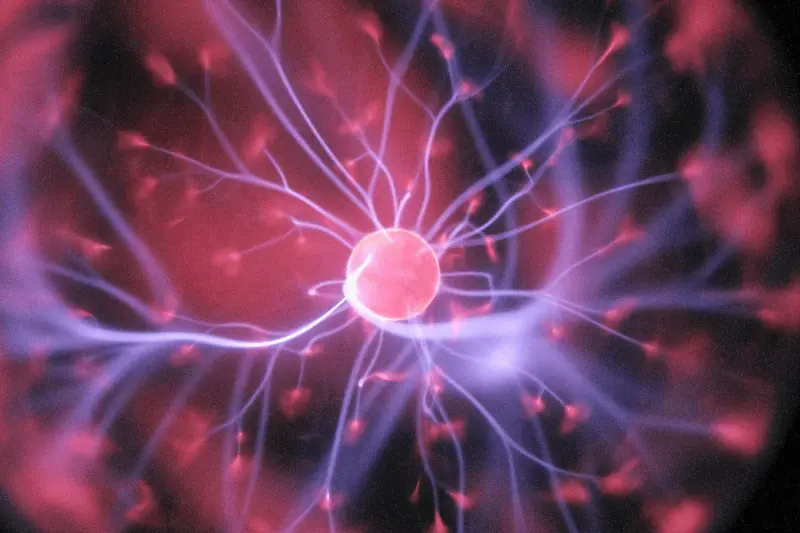
Scientific Findings
Researchers have documented varied effects of Amanita muscaria on the nervous system. These findings are crucial for understanding how this mushroom works. Some studies highlight its potential to protect nerve cells, which could be groundbreaking for treating neurological diseases.
Evidence points towards Amanita muscaria’s antiviral activity against certain strains. This suggests it might help fight off some viruses, a promising avenue for future medicines. The research is still in early stages but shows significant potential.
There is ongoing research into the genetic makeup and bioactive compounds of Amanita muscaria. Scientists believe these components could explain the mushroom’s unique properties. They aim to unlock new treatments by understanding these elements better.
Medical Research
Clinical trials are exploring the safety and efficacy of Amanita muscaria for treatment uses. Researchers are cautious but optimistic about finding beneficial applications. They focus on ensuring that any therapeutic use will not harm patients.
Investigations into therapeutic doses and methods of administration are underway.
- Researchers look at different ways to safely consume Amanita muscaria.
- They study various dosages to find the most effective yet safe amount. This research aims to optimize how we might use this mushroom in medicine.
Studies on interaction with conventional medications are critical. They ensure that using Amanita muscaria won’t cause adverse reactions when taken with other drugs. This aspect of research helps doctors understand how it can fit into broader treatment plans.
Research into long-term effects on health is essential for understanding possible risks or benefits over time. Scientists want to know if there are any negative consequences from using Amanita muscaria regularly.
Potential Therapeutic Uses of Amanita Muscaria
Anxiety Reduction
Amanita muscaria has been reported to have calming effects. People often mention feeling more relaxed after using it. This mushroom could change how we treat anxiety disorders.
Research is looking into how Amanita muscaria affects stress response systems in the brain. It seems to work differently than current anxiolytics, which are drugs used to reduce anxiety.
This mushroom might offer a new way to help people with anxiety. Unlike traditional medications, it may have fewer side effects.
Pain Relief
Amanita muscaria contains compounds that appear to act like natural painkillers. Scientists are studying these properties closely.
They’re interested in how this mushroom can help with chronic pain management. The focus is on its analgesic, or pain-relieving, capabilities.
For those suffering from neuropathic pain, this could be good news. Amanita muscaria might become a non-opioid option for managing their discomfort.
Sleep Disorders
The sedative properties of Muscimol, found in Amanita muscaria, could aid insomnia treatment. Research is delving into its impact on sleep quality and structure.
Studies suggest it might help regulate sleep-wake cycles better than some current treatments do. This makes it a potential natural remedy for various sleep disturbances.
Micro-Dosing Amanita Muscaria Benefits
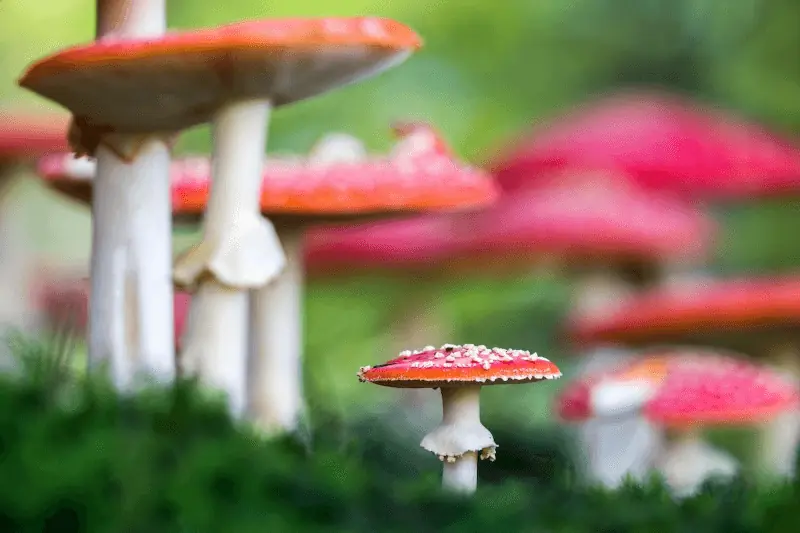
Wellness Improvement
Microdoses of Amanita muscaria may enhance overall well-being. Users report feeling more balanced and in tune with their surroundings. This could be a significant step forward in holistic health practices.
The mushroom has been studied for its potential to support mental health maintenance. Small, controlled doses might help manage stress and anxiety levels. This approach aligns with the growing interest in natural remedies for mental wellness.
Amanita muscaria is also being investigated for its adaptogenic-like properties. These substances help the body resist physical, chemical, and biological stressors. Thus, microdosing could offer a natural way to boost resilience against daily pressures.
Psychedelic Experiences
Microdose users often describe vivid dreams and visions after consuming Amanita muscaria. These experiences can vary widely among individuals but are generally seen as positive and enlightening.
Some people use these psychedelic experiences as tools for spiritual exploration. They report deeper insights into their minds or the universe around them. This practice echoes ancient traditions where such mushrooms played ceremonial roles.
The therapeutic applications of these psychedelic experiences are gaining attention from scientists worldwide. Researchers are exploring how microdoses might aid in treating various psychological conditions or foster profound personal growth.
Comparisons with Other Mushrooms
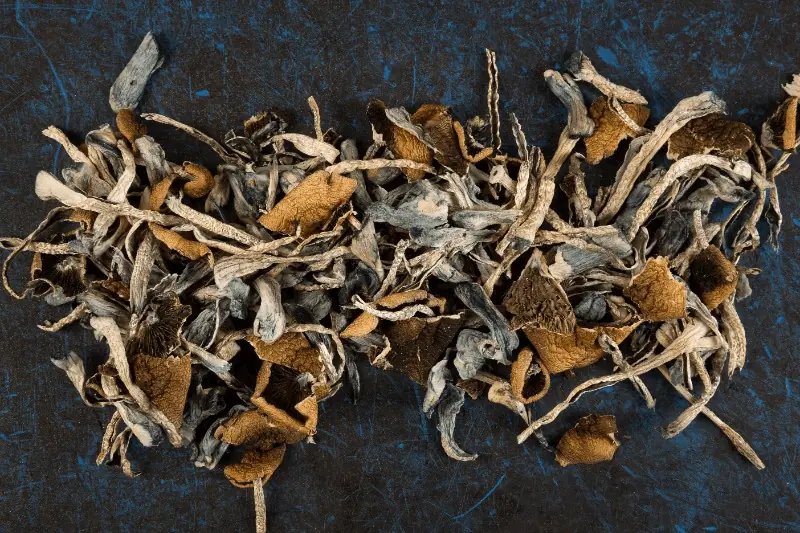
Psilocybin Mushrooms
Psilocybin mushrooms and Amanita muscaria are different species. They share some uses but differ in key areas. Let’s explore these differences.
Amanita muscaria is known for its iconic red cap with white spots. Psilocybin mushrooms, on the other hand, have a variety of appearances. Both types have been used historically for their psychoactive effects.
The primary compound in psilocybin mushrooms is psilocybin. It converts to psilocin in the body, causing psychedelic effects. These effects are distinct from those of muscimol found in Amanita muscaria.
Legal status varies greatly between countries for both mushroom types. In many places, possession and use of psilocybin mushrooms are illegal or controlled substances. However, recent research into their potential mental health benefits has sparked debates about legal reform.
Both Amanita muscaria and psilocybin mushrooms have been studied for their potential mental health benefits. Researchers look at how they might help treat conditions like depression, anxiety, and PTSD. While both show promise, it’s important to note that self-medication without professional guidance can be dangerous.
In comparison:
- Amanita Muscaria
- Contains muscimol as the active compound
- Legal status varies less dramatically compared to psilocybin
- Historically used more for its sedative than psychedelic properties
- Psilocybin Mushrooms
- Contain psilocybin which converts to psilocin
- Known primarily for their strong psychedelic effects
- Subject to stricter legal controls worldwide due to these potent effects
Both mushroom types offer unique experiences and potential therapeutic applications. Their differing compounds lead to distinct experiences during use. As research continues, we may see changes in how societies view and regulate these fungi.
It’s crucial that any use of either type follows local laws and guidelines. Seeking advice from medical professionals before exploring their benefits is advised.
By understanding the similarities and differences between Amanita Muscaria and Psilocybin Mushrooms, individuals can make informed decisions about their use within legal boundaries.
Legal Status and Regulations

Consumption Precautions
Proper identification of Amanita muscaria is essential. Mistaking it for other mushrooms can lead to poisoning. It’s not just about picking any red mushroom with white spots.
Raw consumption of this mushroom has been linked to severe gastrointestinal upset. Symptoms can be unpleasant and dangerous. Cooking or drying may reduce these effects, but caution is still advised.
Before using Amanita muscaria, consulting with a professional is wise. They can provide advice on safety and potential risks. This step should not be skipped.
Being aware of the legal status in your area is necessary to comply with local laws. Regulations vary widely across regions, making it crucial to stay informed.
Dosage Guidelines
The appropriate dosage for Amanita muscaria varies based on its form – dried, fresh, or extract.
It’s recommended to start with low doses to assess individual tolerance. Reactions can differ greatly from person to person.
Exceeding the recommended doses might lead to negative side effects such as confusion or nausea. Guidelines are often based on anecdotal evidence due to a lack of formal research. Understanding these guidelines helps minimize risks associated with its use.
Risks and Safety Profile
Toxicity Concerns
Amanita muscaria, while known for its hallucinogenic properties, carries significant toxicity concerns that cannot be overlooked. Symptoms of an overdose can range from mild to severe. Users might experience confusion, intense nausea, and uncontrollable muscle twitching. These symptoms signal the body’s reaction to the toxic compounds present in the mushroom.
The long-term use of Amanita muscaria is a grey area in scientific research. The full spectrum of risks associated with prolonged consumption remains under-researched. This uncertainty places a veil over its safety profile, urging users to proceed with caution.
Moreover, Amanita muscaria has been noted for potentially dangerous interactions when combined with alcohol or other drugs. Such combinations can exacerbate the effects of toxicity, leading to more severe health consequences.
In cases where poisoning is suspected after consuming Amanita muscaria, seeking immediate medical attention is crucial. The unique chemical makeup of this mushroom means that timely intervention can be pivotal in managing symptoms effectively.
Given these considerations on toxicity and safety concerns related to Amanita muscaria benefits discussed earlier about their potential therapeutic applications—it becomes evident why understanding both sides is essential for informed decision-making regarding their use.
Addiction Treatment Potential
Modern Use
Amanita muscaria, commonly known as the fly agaric mushroom, has seen a resurgence in interest for its medicinal and therapeutic applications. This surge stems from both historical uses and modern-day explorations into alternative treatments for various conditions, including addiction.
Researchers and practitioners are delving into how this mushroom could aid in addiction treatment. Its psychoactive properties, primarily due to compounds like ibotenic acid and muscimol, may alter perception and potentially reduce withdrawal symptoms or cravings associated with substance abuse. However, these studies are in their infancy, facing legal and societal hurdles.
In some cultures, traditional ceremonial use of Amanita muscaria persists. These practices often aim at spiritual healing or enlightenment rather than recreational enjoyment. They offer insights into how the mushroom’s effects have been harnessed respectfully across generations.
Despite its potential benefits, recreational use of Amanita muscaria is controversial. The line between medicinal application and recreational misuse is thin. Recreational users seek it for its hallucinogenic effects without considering the risks involved. This behavior not only endangers individuals but also complicates scientific research efforts aimed at understanding the mushroom’s therapeutic potential.
The legality of Amanita muscaria varies by country but generally falls into a gray area where it might be legal to possess but illegal to sell or consume for its psychoactive effects. These legal restrictions significantly affect availability for both researchers looking to study its benefits further and individuals seeking it out for personal use.
- Pros:
- Potential medicinal benefits.
- Traditional practices highlight respectful use.
- Cons:
- Legal barriers hinder research.
- High risk when used recreationally.
Understanding these aspects is crucial when discussing Amanita muscaria’s role in treating addiction or other health issues.
Ready to Experience the Benefits of Amanita Muscaria?
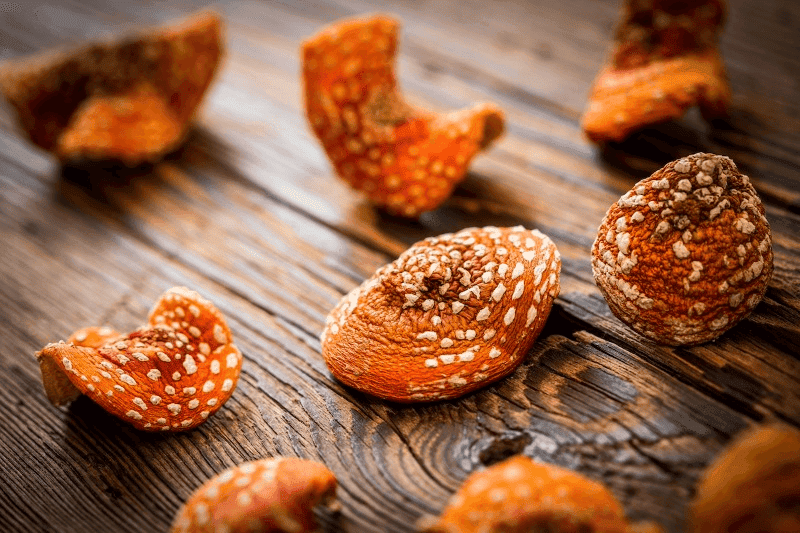
Amanita muscaria, with its distinctive appearance and complex chemical composition, presents a compelling case for both scientific and medicinal exploration. Research underscores its potential in treating various conditions, from neurological disorders to addiction, highlighting its therapeutic uses and micro-dosing benefits. However, the mushroom’s legal status varies globally, necessitating a cautious approach to its consumption and application due to its psychoactive properties and associated risks. The collective evidence suggests that while Amanita muscaria holds promise for certain medical applications, further studies are essential to fully understand its efficacy and safety profile. This exploration encourages healthcare professionals and researchers to delve deeper into its potential, fostering a broader understanding of its benefits and limitations within the medical community.
Readers are urged to consider the implications of these findings for alternative treatments and contribute to ongoing discussions surrounding natural remedies. The journey towards comprehending Amanita muscaria’s full potential is just beginning, inviting more research and dialogue in this intriguing field of study.
Thanks for reading our latest guide, we hope that it helped inform you about amanita muscaria benefits. If you found this guide helpful, please help spread the word about Amanita Explorer and join our newsletter to get our latest articles, buyer’s guides, and news sent straight to your inbox.
Frequently Asked Questions
What is Amanita Muscaria?
Amanita muscaria, commonly known as the fly agaric, is a mushroom species renowned for its distinctive red and white spotted appearance. It contains psychoactive compounds.
Can Amanita Muscaria be used medicinally?
Yes, it has been explored for medicinal properties including anti-inflammatory effects and potential in treating neurological disorders.
What are the main chemicals found in Amanita Muscaria?
The primary psychoactive substances are ibotenic acid and muscimol, which contribute to its effects on the human brain.
Is micro-dosing Amanita Muscaria beneficial?
Micro-dosing may offer benefits such as improved mood and creativity; however, further research is needed to fully understand its efficacy and safety.
How does Amanita Muscaria compare with other mushrooms?
Unlike many edible or medicinal mushrooms, Amanita muscaria is known for its psychoactive properties rather than nutritional value. It requires careful handling due to its potent compounds.
What are the risks of consuming Amanita Muscaria?
Consumption can lead to adverse effects like nausea, confusion, or hallucinations due to its psychoactive chemicals. Proper preparation and dosage are critical.
Is there any addiction treatment potential in Amanita Muscaria?
Emerging studies suggest potential uses in addiction treatment; however, conclusive evidence supporting these claims remains limited at this stage.
